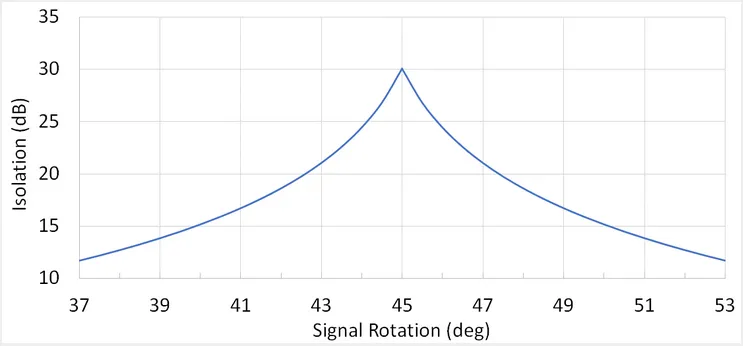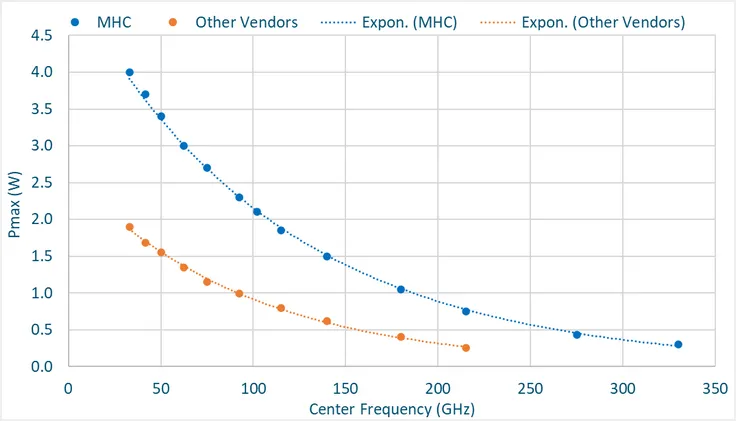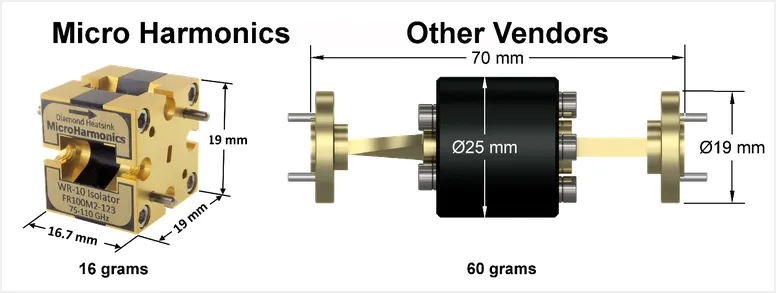How to Choose an Isolator for a Millimeter-Wave System
Millimeter-wave (MMW) systems often employ isolators to suppress standing waves and achieve optimal performance. Isolators pass an RF signal traveling in the forward direction while absorbing signals traveling in the reverse direction. The absorbed signal is converted to heat energy in a resistive load internal to the isolator.
There are a number of ways to implement the isolator function. For example, an isolator can be formed by terminating one port of a circulator. This discussion is restricted to the most common type of isolator at the higher MMW frequencies, which is the Faraday rotation isolator in rectangular waveguide. A further delineation is made between isolators that operate in magnetic saturation and those that do not. This distinction is helpful in understanding the unique performance characteristics of the two types. The majority of isolators on the commercial market are the unsaturated type while those produced by Micro Harmonics Corporation (MHC) are the saturated type.
It is common to think of isolators simply in terms of how well they isolate (how well they absorb the reverse traveling signal). But there are many other important attributes which should be taken into consideration. We will look at nine distinct characteristics.
1: Bandwidth – Faraday rotation isolators are inherently broadband since the rate of signal rotation in the ferrite rod is largely independent of frequency. Both types of isolators, saturated and unsaturated, are capable of bandwidths well in excess of a standard waveguide band (40%). For example, the MHC WR-10 isolator gives very good performance over the extended waveguide band from 67-118 GHz, a fractional bandwidth of 55%.
2: Isolation – MMW isolators typically have more than 20 dB isolation (and often more than 30 dB isolation) across full waveguide bands. Maximum isolation occurs when the signal polarity is rotated 45° as it propagates through the ferrite rod. This puts the electric field vector into the plane of an internal resistive layer. The rotation must be precisely 45° to obtain 30 dB levels. Even small rotational errors of ± 2° can reduce the isolation from 30 dB to near 20 dB as indicated in the graph.
The unsaturated isolators have a slight advantage here. They use a much longer ferrite rod and a permanent magnet to produce the magnetic bias. When the magnet is perfectly aligned to the ferrite rod, the signal rotation is much greater than 45°. The magnet is then rotated off-axis and locked into place when the optimal isolation is achieved. This tuning procedure can even overcome small misalignments of the resistive layer to the waveguide. Conversely, precise control over both the ferrite rod length and alignment of the resistive layer are critical for the saturated type. But there are inherent advantages to using a saturating magnetic bias which are discussed in the next section.
3: Insertion Loss – This is a measure of how much loss is incurred as the RF signal traverses through the isolator in the forward direction. No loss is ideal. This is perhaps the most important measure for MMW isolators because of the difficulty and expense of generating MMW signal power. A primary concern of MMW system designers is minimizing loss and preserving signal power. Using an isolator with the lowest possible insertion loss helps to ensure that the maximum output is achieved.
The predominate loss mechanism in isolators is loss in the ferrite material. Saturated isolators like those made by Micro Harmonics (MHC) use the shortest possible ferrite rod length to achieve the required 45° rotation. Since the ferrite rod is significantly shorter, the insertion loss is minimized. The table below shows RF signal transmission for both types of isolators (50% transmission equates to an insertion loss of 3 dB). In the WR-4.3 band 170-260 GHz, an MHC isolator has a transmission of more than 70% (1.4 dB insertion loss). In the same band, the unsaturated competitor products are closer to 25% (6 dB). By using the unsaturated isolator in your system, you are throwing away 75% of your RF signal power.
In the case where there is signal power to spare, the lowest loss isolator is still the best choice. The RF source can simply be “turned down”. This lowers the operating temperature, increases the mean time to failure, and decreases the power consumption. Conversely, when an isolator with high insertion loss is used, the signal source must be driven harder to overcome the loss. The system runs hotter, fails more quickly, uses more power, has higher noise, and generates more harmonic content.
There are other costs to using a high insertion loss isolator. Because the RF signal power is reduced, it may be more difficult to meet the system specification. This can lead to many additional hours of tuning and testing and missed deadlines.
4: Frequency Coverage – Traditional style, unsaturated isolators are commercially available from over a dozen vendors at frequencies up to the WR-10 band (75-110 GHz). A few vendors have models up to the WR-6.5 band 110-170 GHz. Fewer still offer models up to WR-4.3 band. Micro Harmonics produces and stocks isolators up to the WR-2.8 band 260-400 GHz. It is no mystery why few vendors offer the traditional style isolators at the higher MMW bands. Who can afford that type of loss in their system?
5: Power Handling – MHC isolators employ a unique diamond heatsink that substantially lowers the internal temperature. This means that they can handle more power while operating at much lower internal temperatures when compared to competitor products. No other vendor offers this. The graph below shows the maximum reverse power ratings of the MHC isolators and the average of other vendors. The MHC power ratings are conservative to ensure low internal temperatures and long life.
6: Port Reflections – The primary function of an isolator is to absorb reflected signals and suppress standing waves. But if an isolator has high reflections at the ports, you are simply trading one reflection for another. Port reflections are often expressed in terms of VSWR. The lower the VSWR, the better. The VSWRs of saturated and unsaturated isolators are similar.
7: RF Test Data – MMW isolators have unique signatures that arise from small misalignments and variations in the internal parts. The differences in the performance between one isolator and the next can be substantial. Max, min, and typical specs are helpful, but what you need to see is the actual test data for the isolator you are buying. Micro Harmonics tests every isolator across the full waveguide band on a vector network analyzer. The RF test data is supplied to the customer at no additional cost.
8: Stray Magnetic Fields – Small external magnetic fields can alter the operating point of an isolator and substantially degrade the performance. Traditional style, unsaturated isolators are sensitive to even small stray magnetic fields. This is contrary to what many engineers assume since the traditional isolators employ a magnetic sheath around the main body. But this sheath does not protect against axial magnetic fields which are precisely the ones that alter the Faraday rotation and degrade the isolator performance. MHC isolators are not affected by external magnetic fields because the ferrites are biased hard into magnetic saturation. It would require a very high magnetic field in exactly the opposite polarity to pull the MHC isolator out of saturation and perturb the performance.
9: Size & Weight – Size and weight are often important considerations for MMW system designers. Micro Harmonics produces the most compact and lightest weight isolators on the global market. For example, in the WR-10 band 75-110 GHz, an MHC isolator has external dimensions of 19 x 19 x 16.7 mm and weighs only 16 grams. A typical competitor isolator in the same band measures 25 x 25 x 70 mm and weighs 60 grams. The difference is a factor of four in both size and weight.
Conclusion
A variety of manufacturers produce MMW Faraday rotation isolators that exhibit high isolation and low VSWRs across full waveguide bands. But there is a wide gap in performance when it comes to insertion loss. The isolators made by Micro Harmonics have the lowest insertion loss by a wide margin. This is one reason why their isolators are offered at much higher frequency bands.
Additionally, Micro Harmonics isolators have unique diamond heatsinks which channel heat away from the internal resistive load. This substantially lowers the internal operating temperature leading to reduced failure rates and higher power ratings. The MHC isolators are also much smaller and lighter weight than the traditional style isolators. Lastly, MMW isolators have unique signatures across their operating bands which cannot be sufficiently characterized using “typical” specifications. If the manufacturer tested your isolator, they can easily provide the data. If you have any additional questions, feel free to contact us!




